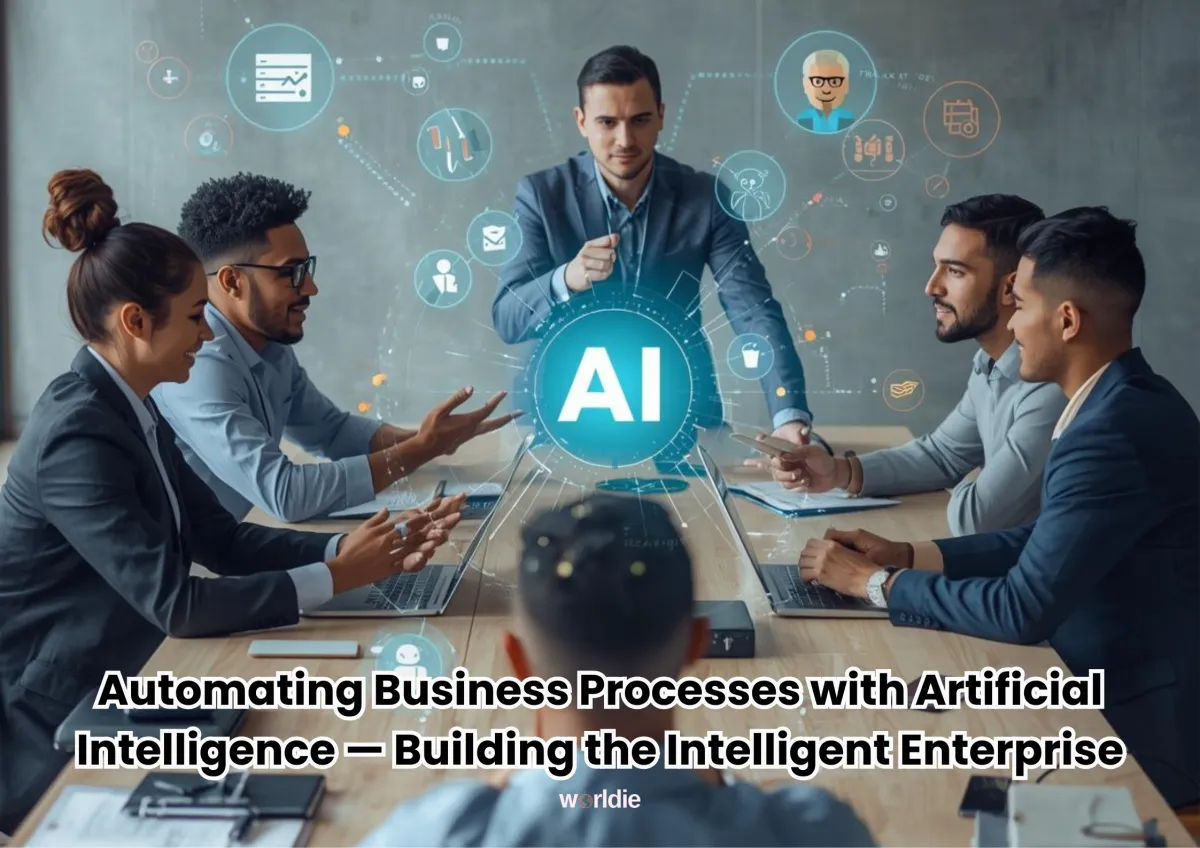
Automating Business Processes with Artificial Intelligence — Building the Intelligent Enterprise
Automating business processes with artificial intelligence is no longer just a technological advantage — it’s a strategic imperative for organizations aiming to scale, innovate, and operate efficiently in competitive markets. For many growth-focused companies, the challenge isn’t about understanding what AI is, but how to apply it systematically across departments to drive measurable ROI and long-term transformation. Worldie AI specializes in helping businesses design, build, and deploy cohesive AI systems that remove operational friction, elevate decision-making, and accelerate revenue.
Understanding What It Means to Automate with AI
At its core, automating business processes with artificial intelligence refers to leveraging machine learning, predictive analytics, and intelligent automation to streamline repetitive workflows, optimize resources, and enable faster decisions. Unlike traditional automation tools, which follow static rules, AI-driven automation learns and improves over time. It recognizes patterns, adapts to changing inputs, and helps teams focus on strategic, high-value work instead of manual tasks.
When done right, AI doesn’t replace human expertise — it amplifies it. A marketing team using AI can predict lead behavior more accurately. Operations managers can anticipate supply chain disruptions before they occur. Executives can see real-time business insights without waiting for reports. This combination of speed, intelligence, and adaptability is the hallmark of AI-led process automation.
Where Businesses Struggle Before Automation
Many organizations face hidden inefficiencies that quietly erode productivity. Manual data entry, fragmented software systems, disconnected workflows, and decision bottlenecks are common symptoms. Employees spend hours consolidating information from CRMs, spreadsheets, or outdated ERP systems. Departments operate in silos, with marketing, sales, and operations rarely sharing unified insights.
These inefficiencies lead to slower response times, inaccurate forecasting, and poor resource allocation. The truth is, businesses that don’t integrate automation remain reactive — constantly catching up instead of moving ahead. AI changes that by enabling predictive systems that act before issues arise, making operations proactive and intelligent.
The Strategic Role of AI in Business Process Automation
Automating business processes with artificial intelligence is more than a technological upgrade — it’s a redefinition of how businesses create value. When AI systems are integrated across departments, they transform how organizations collect, process, and act on data.
In marketing, AI can automate customer segmentation, lead scoring, and campaign optimization. In sales, it can predict which prospects are most likely to convert and personalize interactions based on behavioral data. In operations, AI can optimize supply chain logistics, predict equipment maintenance needs, and balance workloads with precision.
AI-powered process automation acts as a connective layer that ensures every function of the business communicates seamlessly. It transforms disconnected processes into a unified ecosystem, where data flows intelligently, and actions are executed with minimal manual intervention.
Industry Applications That Demonstrate the Power of AI Automation
AI automation is already revolutionizing industries across the globe. In healthcare, machine learning models process massive datasets to streamline patient triage, appointment scheduling, and billing. In finance, AI automates fraud detection and risk assessment with near-instant accuracy. Retailers use AI to predict consumer demand and automate inventory restocking. Manufacturing companies rely on predictive maintenance algorithms to prevent costly equipment failures.
Each example showcases one principle — AI doesn’t just automate what’s manual; it optimizes what’s already functional. That’s the distinction between routine automation and intelligent transformation.
How Worldie AI Approaches Intelligent Automation
Worldie AI follows a structured three-phase framework — Design, Build, and Release — ensuring automation is not only implemented but strategically aligned with each company’s business model.
The Design phase focuses on understanding the organization’s existing workflows and uncovering hidden inefficiencies. It’s not about installing AI tools; it’s about identifying where AI can deliver maximum impact. The Build phase involves developing customized AI systems — predictive models, data pipelines, and automation frameworks — that integrate with existing infrastructure. The Release phase ensures seamless deployment, testing, and scaling, allowing the business to see measurable improvements in efficiency and revenue.
This methodology ensures that automation aligns with strategic outcomes rather than isolated tasks. The end result is not just faster workflows but smarter ecosystems that evolve with the business.
Challenges That Can Derail AI Automation Initiatives
While AI offers transformative potential, many organizations underestimate the complexity of implementation. Common challenges include poor data quality, fragmented systems, lack of in-house expertise, and resistance to change. AI thrives on accurate, structured data — without it, even the best algorithms underperform. Integration with legacy software often introduces compatibility issues. Teams must also adapt to new workflows that rely on automation insights instead of manual validation.
Successful automation depends on strategy, governance, and continuous iteration. Companies that treat AI as a one-time project often struggle. Those that adopt it as an evolving capability see sustained growth and improved agility.
Overcoming Integration Barriers
Integration is where many automation projects fail. Businesses often attempt to overlay AI systems on top of outdated infrastructure, leading to inefficiencies instead of optimization. The solution lies in creating interoperability — connecting CRMs, ERPs, marketing automation tools, and analytics platforms into a single data ecosystem.
Worldie AI approaches integration with a systems-thinking mindset, ensuring every process communicates with the next. The goal isn’t just to automate tasks but to enable data-driven synchronization across the organization.
Metrics That Define Success in AI-Driven Automation
To measure the impact of automating business processes with artificial intelligence, businesses should look beyond cost reduction. Key indicators include cycle-time reduction, accuracy improvement, increased customer engagement, predictive insights accuracy, and overall ROI uplift.
Worldie AI often tracks performance across three dimensions — operational efficiency, decision velocity, and customer satisfaction. When AI is implemented effectively, teams make faster decisions, operations run smoother, and customers experience higher-quality service. These outcomes become measurable, repeatable, and scalable.
Building a Culture That Supports AI Automation
Technology can only go as far as the people using it. For automation to succeed, leaders must foster a data-first culture where employees view AI as an enabler, not a replacement. Training programs, clear communication, and change management strategies help teams embrace new workflows confidently.
Worldie AI partners with clients to embed this mindset early, ensuring that human and artificial intelligence operate in harmony rather than competition.
Real-World Transformations Through AI Automation
Across sectors, businesses have seen measurable transformation through intelligent automation. A logistics company reduced shipment delays by 40% by using AI to predict route disruptions. A SaaS provider increased sales productivity by 60% through automated lead scoring. A healthcare group improved patient experience scores by automating administrative workflows.
These examples highlight what happens when automation is aligned with strategic intent — tangible business outcomes that drive both efficiency and revenue growth.
The Future of AI-Driven Automation
The next evolution of AI automation goes beyond task execution. Emerging systems will act as autonomous collaborators — capable of making real-time adjustments, learning from human feedback, and self-optimizing across entire business ecosystems. As machine learning and process automation converge, businesses that adopt integrated AI frameworks will see compounding growth effects.
Worldie AI continues to lead this evolution, helping organizations build AI architectures that evolve intelligently with their goals.
Why Strategic AI Automation Is a Competitive Necessity
Businesses that adopt AI strategically are rewriting the rules of competition. They move faster, adapt better, and deliver value more efficiently. Companies that delay automation risk being outpaced not by larger competitors but by smarter ones — those that use data, prediction, and automation as their growth engine.
AI automation isn’t just about cost savings. It’s about unlocking new business models, new customer experiences, and new ways to scale sustainably.
FAQs About Automating Business Processes with Artificial Intelligence
1. How do I know which processes in my business should be automated first?
Start with workflows that are repetitive, data-heavy, and rule-based but require accuracy and consistency. Processes like lead qualification, invoice processing, and customer support routing often show the fastest ROI when automated with AI.
2. What’s the biggest mistake companies make when automating with AI?
Many organizations jump straight to implementation without a strategy. They purchase AI tools without aligning them to business goals or data readiness. AI needs a strong foundation of clean data and clear objectives to perform effectively.
3. Can small or mid-sized businesses afford AI-driven automation?
Yes. Scalable cloud-based AI platforms and modular automation tools have made advanced capabilities accessible to smaller enterprises. The focus should be on starting small, automating one process at a time, and expanding based on proven returns.
4. How long does it take to see measurable results from AI automation?
Depending on complexity, businesses typically see noticeable improvements within three to six months after deployment. Predictive accuracy and efficiency gains continue to compound as AI systems learn and adapt over time.
5. What role does Worldie AI play in automation success?
Worldie AI helps businesses design tailored automation systems that align with their operations and growth goals. From strategy design and model training to integration and scaling, the focus is on measurable outcomes — efficiency, accuracy, and revenue growth.

